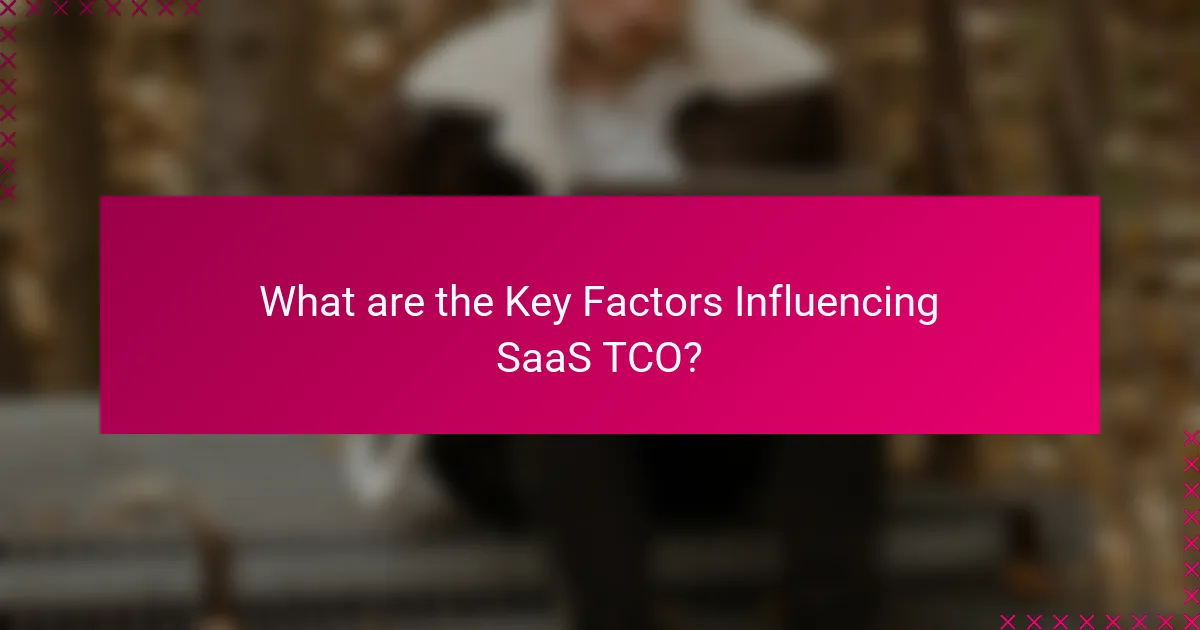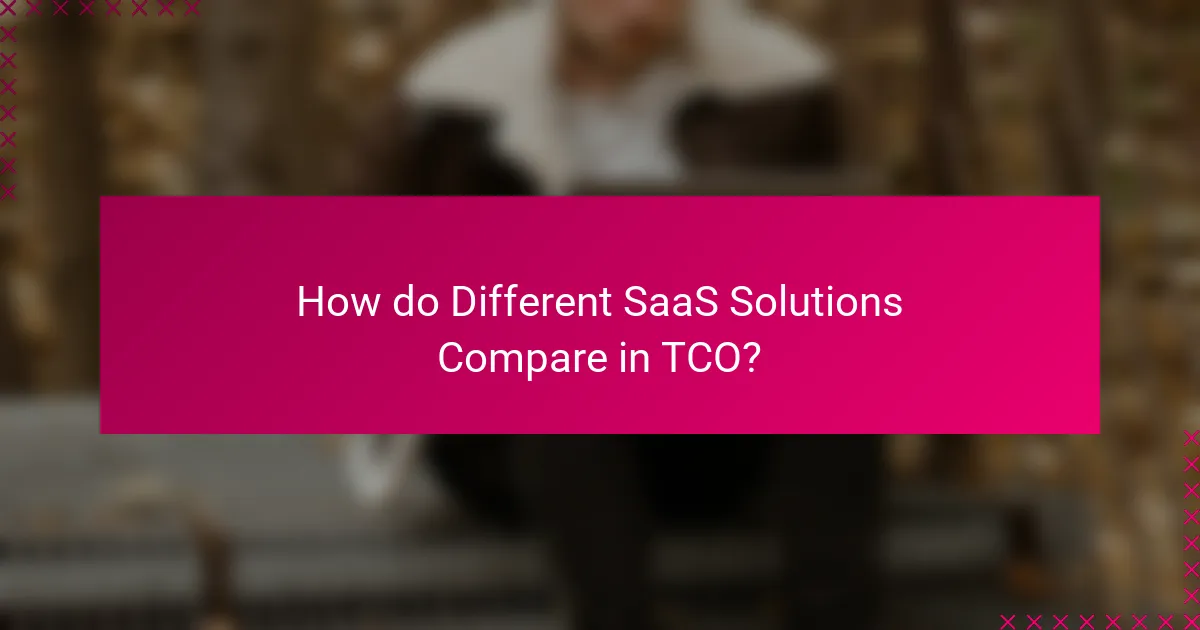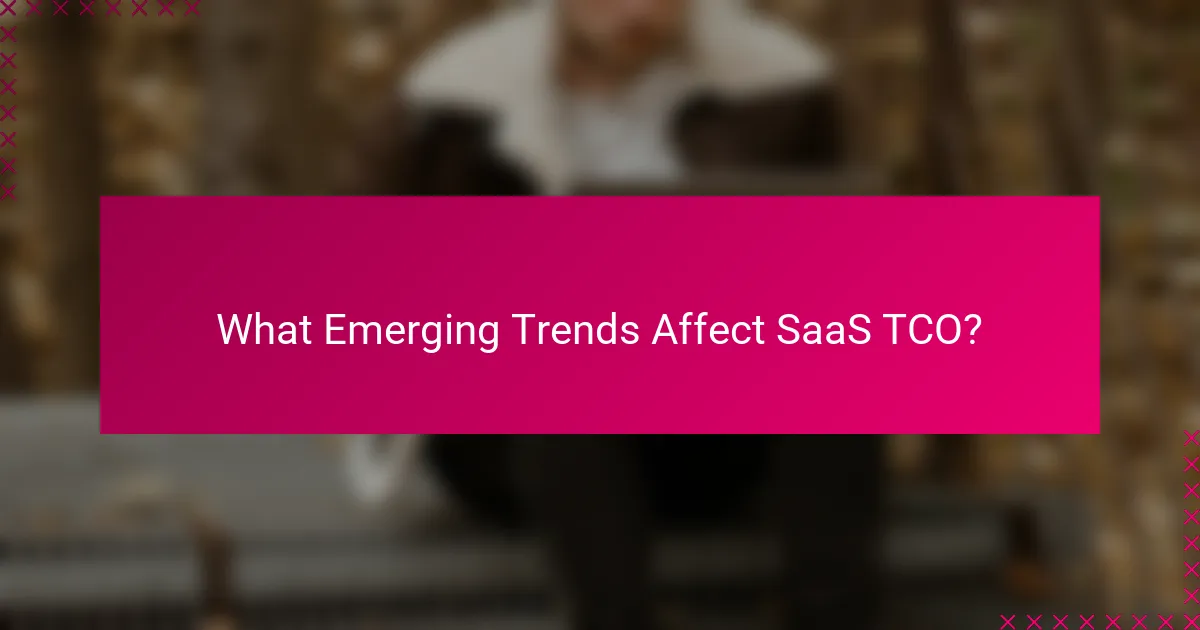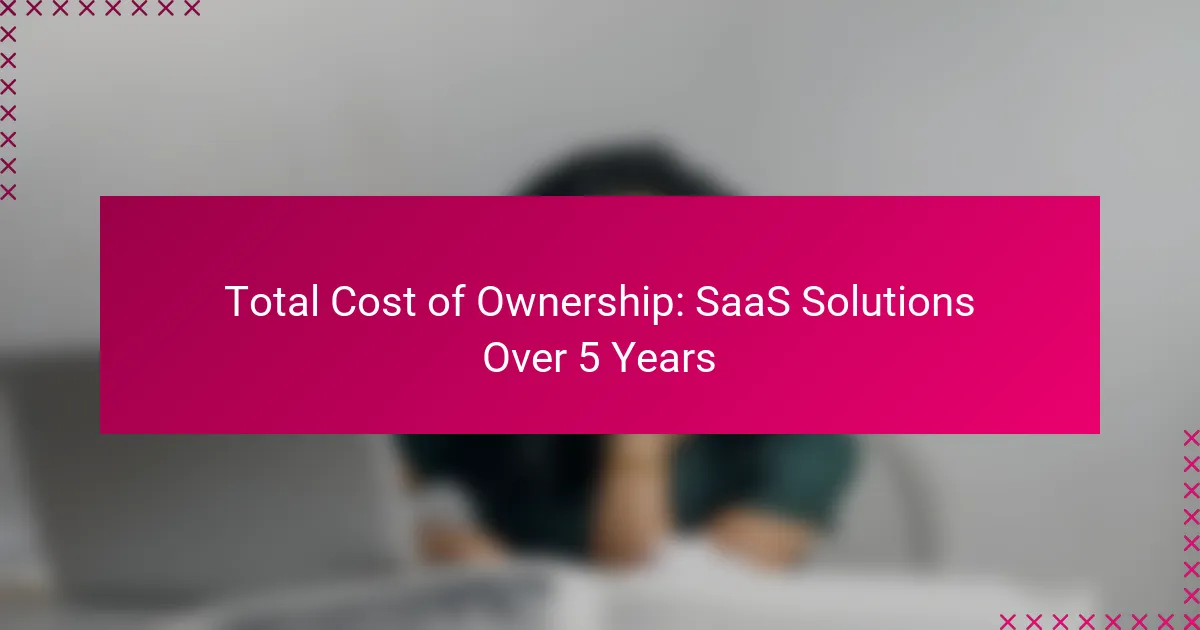The Total Cost of Ownership (TCO) for Software as a Service (SaaS) solutions over a five-year period includes all direct and indirect expenses associated with these services. This comprehensive assessment covers subscription fees, implementation, maintenance, support, and potential hidden costs, providing organizations with a clear understanding of their software investments. By evaluating factors such as vendor reliability and integration capabilities, businesses can make informed decisions that align with their long-term goals.

What is the Total Cost of Ownership for SaaS Solutions in Canada?
The Total Cost of Ownership (TCO) for Software as a Service (SaaS) solutions in Canada encompasses all direct and indirect costs associated with using these services over a five-year period. This includes subscription fees, implementation costs, maintenance, support, and any potential hidden costs that may arise during the usage of the software.
Definition of Total Cost of Ownership
Total Cost of Ownership (TCO) is a financial estimate that helps businesses understand the complete costs associated with acquiring and using a product or service. For SaaS solutions, TCO includes not only the initial subscription costs but also ongoing expenses such as training, upgrades, and potential downtime. Understanding TCO allows organizations to make informed decisions about software investments.
In the context of SaaS, TCO can be broken down into several components: initial setup costs, monthly or annual subscription fees, costs related to user training, and any additional expenses for integrations or customizations. This comprehensive view helps businesses avoid underestimating the financial commitment involved.
Importance for SaaS Decision-Making
Evaluating the Total Cost of Ownership is crucial for effective SaaS decision-making, as it provides a clearer picture of long-term financial implications. By analyzing TCO, organizations can compare different SaaS solutions more accurately, ensuring they choose the option that offers the best value over time.
For example, a lower subscription fee may seem attractive initially, but if the TCO reveals high training or support costs, the overall expense could be significantly higher than a more expensive option with better support and training resources. Businesses should always consider TCO alongside other factors like functionality and user experience to make well-rounded decisions.

How to Calculate Total Cost of Ownership for SaaS?
To calculate the Total Cost of Ownership (TCO) for Software as a Service (SaaS), consider all costs associated with the software over its expected lifespan, typically five years. This includes direct costs like subscription fees, indirect costs such as training and support, and hidden costs related to downtime and migration.
Direct Costs: Subscription Fees
Direct costs primarily consist of the subscription fees paid for the SaaS solution. These fees can vary widely based on the provider, features, and number of users, often ranging from a few dollars to several hundred dollars per user per month. It’s essential to account for any price increases over the contract period.
When evaluating subscription fees, consider whether the pricing model is tiered or flat-rate, as this can significantly impact overall costs. Additionally, some providers may offer discounts for annual payments, which can reduce the total expenditure.
Indirect Costs: Training and Support
Indirect costs include expenses related to training employees and ongoing support. Training costs can vary based on the complexity of the software and the number of users needing instruction, often ranging from a few hundred to several thousand dollars. It’s crucial to factor in both initial training and any refresher courses as needed.
Support costs may also arise, especially if the SaaS provider charges for premium support services. Evaluate the level of support included in the subscription and consider potential additional costs for advanced support options.
Hidden Costs: Downtime and Migration
Hidden costs can significantly impact the TCO, particularly those associated with downtime and migration. Downtime can lead to lost productivity and revenue, with costs potentially reaching thousands of dollars per hour, depending on the business size and industry. It’s important to assess the reliability of the SaaS provider and their historical uptime performance.
Migration costs should also be considered, as transitioning from an existing system to a new SaaS solution often involves data transfer, integration, and potential disruptions. These costs can vary widely, so it’s advisable to budget for both the technical aspects and the time required for a smooth transition.

What are the Key Factors Influencing SaaS TCO?
The total cost of ownership (TCO) for Software as a Service (SaaS) solutions is influenced by several critical factors, including vendor reliability, integration capabilities, and scalability. Understanding these elements helps organizations make informed decisions about their software investments over a five-year period.
Vendor Reliability and Support
Vendor reliability is crucial when assessing TCO for SaaS solutions. A dependable vendor ensures consistent service delivery, minimizing downtime and disruptions that can lead to additional costs. Look for vendors with a strong track record, positive customer reviews, and robust support options.
Support services can significantly impact TCO. Evaluate the availability of support channels, response times, and the quality of assistance provided. Vendors offering 24/7 support and comprehensive documentation can reduce the time and resources spent on troubleshooting issues.
Integration with Existing Systems
Effective integration with existing systems is essential for maximizing the value of a SaaS solution. Poor integration can lead to inefficiencies, data silos, and increased operational costs. Assess the ease of integration with your current software stack and the potential need for additional tools or services.
Consider the costs associated with integration, including potential consulting fees or the need for custom development. A solution that seamlessly connects with your existing infrastructure can save time and reduce overall expenses in the long run.
Scalability and Future Needs
Scalability is a vital factor in determining TCO, as it affects how well a SaaS solution can grow with your organization. A scalable solution allows for easy adjustments in user count, features, and resources without incurring significant additional costs. Evaluate the vendor’s pricing model to understand how costs will change as your needs evolve.
Anticipate future requirements by considering your organization’s growth trajectory. Choosing a SaaS solution that can adapt to changing demands can prevent costly migrations or replacements down the line. Regularly review your needs and the vendor’s offerings to ensure alignment as your business evolves.

How do Different SaaS Solutions Compare in TCO?
The Total Cost of Ownership (TCO) for different Software as a Service (SaaS) solutions varies significantly based on features, user count, and integration capabilities. Evaluating TCO involves considering not only subscription fees but also implementation, training, and ongoing maintenance costs over a five-year period.
Salesforce vs. HubSpot
Salesforce and HubSpot serve different market segments, which influences their TCO. Salesforce typically has a higher upfront cost due to its extensive customization options and robust features, making it suitable for larger enterprises. HubSpot, on the other hand, offers a more user-friendly interface and lower initial costs, appealing to small and medium-sized businesses.
When comparing TCO, consider the additional costs associated with Salesforce, such as integration and training, which can add up to tens of thousands of dollars over five years. HubSpot’s pricing model is more straightforward, with tiered plans that can range from a few hundred to several thousand dollars annually, depending on the features selected.
Microsoft 365 vs. Google Workspace
Microsoft 365 and Google Workspace both provide essential productivity tools, but their TCO can differ based on usage patterns and organizational needs. Microsoft 365 often incurs higher costs due to its extensive suite of applications and advanced security features, making it ideal for larger organizations with complex requirements.
Google Workspace generally offers a more cost-effective solution for smaller teams, with subscription costs typically ranging from $6 to $25 per user per month. However, organizations should also factor in potential costs for additional storage and third-party integrations, which can impact the overall TCO over five years.

What are the Long-Term Benefits of Understanding TCO?
Understanding the Total Cost of Ownership (TCO) for SaaS solutions over five years helps organizations make informed decisions about their software investments. By evaluating both direct and indirect costs, businesses can optimize spending and enhance overall value.
Informed Budgeting and Forecasting
Informed budgeting and forecasting are critical for managing SaaS expenses effectively. By analyzing TCO, organizations can anticipate future costs, including subscription fees, maintenance, and potential upgrades, allowing for more accurate financial planning.
For example, if a company expects a 10% annual increase in user licenses, incorporating this into the budget can prevent unexpected financial strain. Additionally, understanding TCO helps identify areas where costs can be reduced, such as eliminating underused licenses.
Enhanced Vendor Negotiation
Understanding TCO empowers businesses during vendor negotiations by providing a clear picture of total expenses associated with a SaaS solution. This knowledge allows companies to negotiate better terms, such as discounts for longer commitments or additional features at no extra cost.
For instance, if a vendor’s pricing structure is based on user count, knowing the TCO can help a company argue for a fixed price for a certain period, protecting against future price hikes. Companies should also compare TCO across different vendors to leverage competitive pricing effectively.

What Emerging Trends Affect SaaS TCO?
Emerging trends significantly influence the Total Cost of Ownership (TCO) for Software as a Service (SaaS) solutions over time. Understanding these trends can help organizations make informed decisions about their software investments and manage costs effectively.
AI and Automation Impact on Costs
AI and automation are reshaping the cost landscape for SaaS solutions by streamlining operations and reducing manual tasks. Businesses can expect to see lower operational costs as AI tools automate routine processes, which can lead to savings in labor and time.
For example, companies utilizing AI-driven analytics may reduce the need for extensive data analysis teams, cutting costs by potentially 20-30%. However, organizations should consider the initial investment in AI technologies and the ongoing costs of maintenance and updates.
Shift to Subscription-Based Pricing Models
The shift to subscription-based pricing models has made SaaS solutions more accessible but also requires careful cost analysis. While upfront costs may be lower, organizations must evaluate long-term expenses, as subscription fees can accumulate significantly over several years.
For instance, a SaaS application priced at $100 per month may seem affordable initially, but over five years, the total cost could reach $6,000. Companies should assess their usage patterns and determine whether a subscription model aligns with their budget and needs, considering potential price increases and contract terms.
